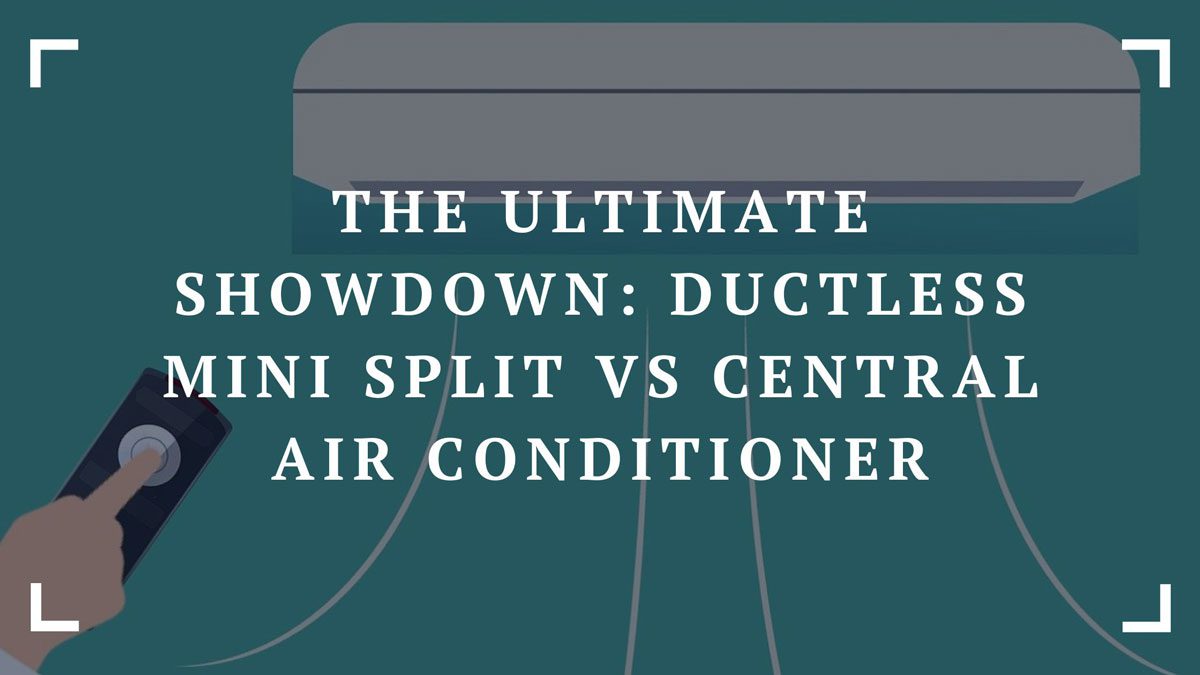When you’re poised to upgrade your home’s comfort, the battle between a ductless mini-split and a central air conditioner can be intense. Both boast unique benefits tailored to different needs and spaces. This ultimate showdown is going to help you decipher which system is the champion for your living quarters. Get ready to weigh cooling efficiency, cost, and installation as we delve into the nitty-gritty of each option.

Duct System
A ductless unit is a sleek, compact solution for homes lacking the space for extensive ductwork. Unlike its central air counterpart, the ductless mini split system comprises an outdoor condenser unit connected to indoor air-handling units through small conduits. These conduits require only a small hole, typically around three inches in diameter, to pass refrigerant, electricity, and drainage lines. Each indoor unit operates independently, allowing for zoned cooling and heating in different rooms without the need for a network of ducts. This design reduces the energy loss often associated with ductwork, making mini-splits more energy-efficient in certain scenarios.
Meanwhile, a central air conditioner relies on a network of ducts that run throughout your home, such as the attic or walls, to distribute conditioned air. This system requires a single outdoor unit connected to one indoor unit that pushes air through the ducts. Central air systems are typically used in homes that already have an existing ductwork infrastructure, promising uniform cooling across the entire house.
Installation Flexibility
The installation flexibility of a ductless mini-split affords it an advantage in various situations. Being duct-free, it is ideal for retrofitting older homes that aren’t suited for the extensive ductwork required by central air systems. Additionally, the compact size and individual zoning capabilities of mini-splits allow for targeted cooling in specific areas, making installation possible in residential expansions like additions or converted spaces.
Conversely, central air conditioners are less flexible in installation and are usually best for homes with pre-existing ducts. Installing new ductwork can be invasive, requiring substantial construction and time. This makes central systems less adaptable and often more costly and disruptive to install in structures without initial ductwork provisions.
Maintenance
When it comes to HVAC system maintenance, there are various concerns you must have in mind. These are the following:
- Air filter replacement
- Inspections
- Thermostat calibration
- Cleaning
- Refrigerant levels
- Electrical compounds
- Professional servicing
- System upgrades and efficiency improvement
Maintenance of a ductless mini-split often involves cleaning filters, monitoring refrigerant levels, and servicing the individual indoor units. Each unit can be serviced separately, which can be less labor-intensive and may reduce maintenance costs. In contrast, central air conditioners require regular duct cleaning to ensure efficiency and prevent dust or mold accumulation, which can be a more complex process.
Central systems also necessitate periodic inspections of the entire ductwork, making maintenance potentially more costly and time-consuming due to the expansive nature of the work required. The centralized operation means that if an issue arises, it typically impacts the entire system, possibly leading to more significant downtime for repairs or maintenance.
Zoning
Mini-splits excel in the aspect of zoning, as they allow for individualized control over different zones or rooms. Each indoor unit has its own thermostat, enabling occupants to adjust the temperature settings to their desired comfort level in specific areas. This feature not only enhances personal comfort but also contributes to energy savings, as you can cool or heat only the spaces in use.
On the flip side, central air systems traditionally operate on a single-zone basis, meaning one thermostat regulates the temperature throughout the entire home. To implement zoning with a central system, you would need to install specialized dampers within the ductwork. This adds complexity and cost to an already elaborate system. While central air conditioners can be adapted for multi-zone control, it is inherently less efficient and more complex than the natural zoning provided by ductless mini-split systems.
Energy Efficiency
The energy efficiency of a ductless mini-split often surpasses that of central air conditioners due to their design advantages. Mini-splits avoid the energy loss commonly associated with the long ductwork of central systems, where leaks and thermal transfer can significantly reduce efficiency.
Their zoned cooling approach means energy is not wasted on unoccupied areas, offering substantial operational savings. In contrast, central air conditioners can suffer from loss of cool air in the ductwork, leading to higher energy consumption as the system compensates for the loss. Although central systems benefit from technology improvements like variable speed fans and advanced compressors, mini-splits generally maintain a lead in energy efficiency, remarkable for their ability to target specific areas for heating and cooling.
Cost of Installation
The cost of installation for a ductless mini-split system can be less prohibitive compared to a central air conditioner, especially in homes without pre-existing ductwork. For a mini-split, expenses center on the number of indoor units and the cost of drilling small holes for the conduit, which can add up but often remains lower than the extensive construction needed for duct installation.
Central air conditioners typically come with higher initial installation costs due to their complex ductwork requirements. If a house already has ducts, the cost difference narrows, but retrofitting a home for central air can be particularly costly, time-consuming, and invasive, tipping the cost scale in favor of the more modular ductless systems.
Aesthetics
When evaluating aesthetics, ductless mini-splits and central air conditioners serve different visual preferences. Mini-splits include visible indoor units that are mounted on walls or ceilings, with modern designs that can be sleek and unobtrusive but still noticeable. They offer more flexibility in placement, potentially blending into the decor or becoming a statement piece. Central air conditioners, while their ducts and vents seamlessly integrate into a home’s architecture, have a more hidden presence.
All major components are concealed within walls, attics, or floors, preserving the original aesthetic of a room without the addition of external units. Ultimately, the choice between the two may come down to a homeowner’s tolerance for visible equipment versus a desire for an unaltered interior look.

As you consider the intricacies of choosing between a ductless mini-split and a central air conditioner, remember to assess your home’s structure, your personal comfort preferences, and energy efficiency desires. Whether valuing installation flexibility, maintenance simplicity, and energy savings with a mini-split or favoring the whole-home comfort and seamless appearance of central air, your decision will define your home’s climate control for years to come. Choose wisely to ensure ultimate satisfaction.


